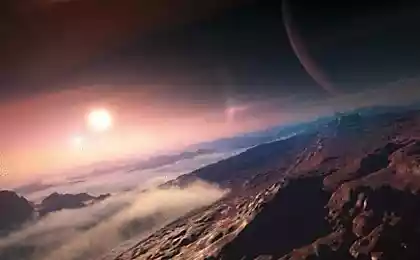920
10 most amazing exoplanets
Exoplanet - a planet that is beyond our solar system. The total number of extrasolar planets in the Milky Way is more than $ 100 billion. Currently, scientists discovered only a small proportion.
10 photos + text here
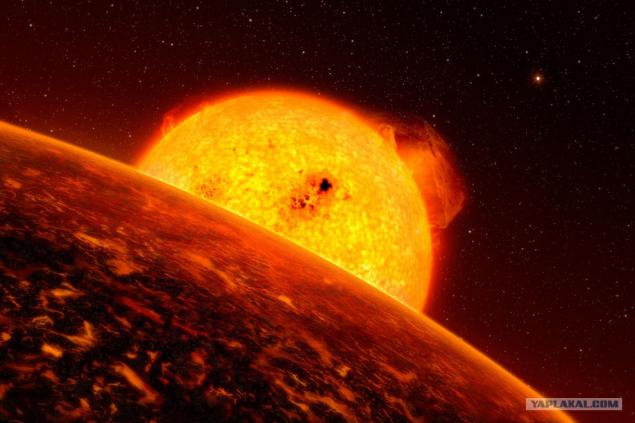
1. WASP-12b
Astronomers saw a cosmic cataclysm: the star absorbs own planet, which was in close proximity to it. This is an exoplanet WASP-12b. It was discovered in 2008.
WASP-12b, as well as most of the known extrasolar planets, is a big gas world. However, unlike most other extrasolar planets, WASP-12b revolves around its star at very close range - a little over 1, 5 million kilometers (75 times closer than the Earth is from the Sun).
Huge world WASP-12b has already looked into the face of his death, the researchers said. The main problem of the planet - its size. It has grown to such an extent that it can not keep its matter against the forces of gravity mother star. WASP-12b gives stellar matter with great speed: six billion metric tons each second. The planet will be completely destroyed by the star in about ten million years. By cosmic standards, it is quite a bit.
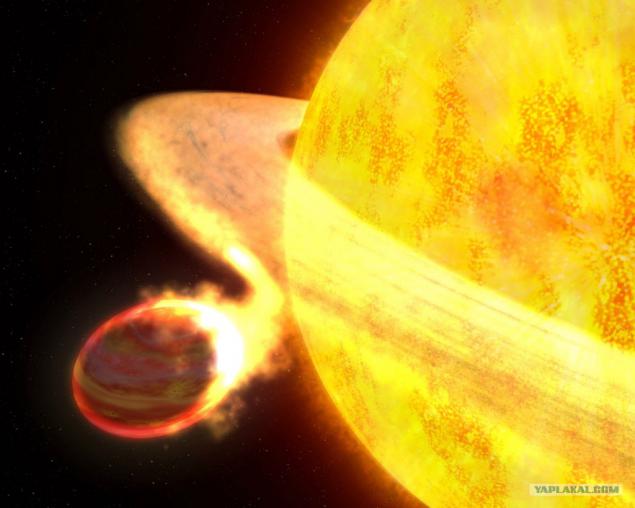
2. TrES-2b
The darkest exoplanet - a distant, Jupiter-sized, gas giant.
Measurements showed that the planet TrES-2b reflects less than one percent of the light, making it blacker than coal and naturally darken any of the planets of the solar system. The work dedicated to this planet, was published in the Journal of the Royal Astronomical Society Monthly Notices. Planet TrES-2b reflects less light than even black acrylic paint, so it's really dark world.

3. HD 189733b
This object orbiting a star, remote from us at a distance of 63 light years. Although this sounds like a planet the size of Jupiter, because of its proximity to its star, it is much hotter than the gas giant in our solar system. As with the other planets found hot, synchronized rotation of the planet and its orbital motion - a planet always faces the star of one side. The orbital period is 2.2 Earth days.
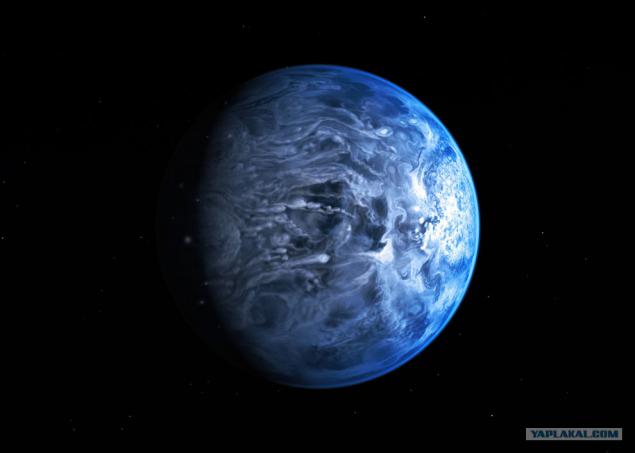
4. TrES-4
The biggest planet of the found in the universe - is TrES-4. It was discovered in 2006 and it is located in the constellation Hercules. The planet orbits the star, which is located about 1,400 light years from Earth.
The researchers argue that the diameter of the planets discovered almost 2 times (or more precisely in the 1, 7), the diameter of Jupiter (it is the biggest planet in the solar system). TrES-4 temperature about 1,260 degrees Celsius.

5. COROT-7b
Year on COROT-7b takes just over 20 hours. It is not surprising that the weather in the world, to put it mildly exotic.
Astronomers have suggested that the planet is composed of cast and solid rock, not from frozen gases that certainly will boil at such usloviyah.Temperatura falls to 2000 C on the illuminated surface to -200 C at night.

6. PSR and PSR 1257 b 1257 c
Two planets revolve around the dying star.

7. Kepler-10b
With Space Telescope, astronomers were able to detect the smallest rocky exoplanet, whose diameter is about 1, 4, the diameter of Earth.
The new planet was designated Kepler-10b. The star around which it rotates, is located about 560 light years from Earth in the constellation Draco, and similar to our sun. Belonging to the class of "super-Earths», Kepler-10b is the rather close to its luminary orbit, making a turn around for just 0, 84 Earth days, the temperature in it reaches several thousand degrees Celsius. According to the scientists, with a diameter of 1, 4 diameter of the Earth Kepler-10b has a lot of 4 and 5 of the earth.
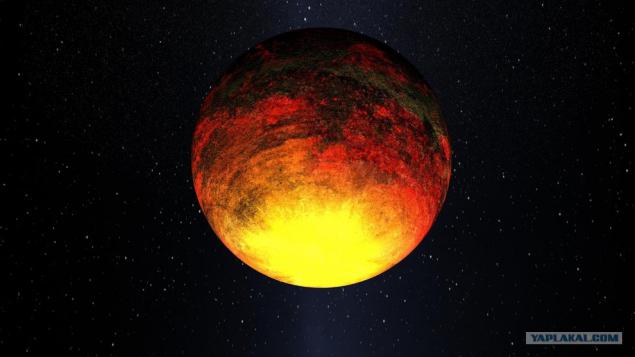
8. Kepler-16b
Analysis of the data on the system Kepler-16 showed that it opened in June 2011 exoplanet Kepler-16b rotates once around the two stars. If the observer could be on the surface of the planet, it would have seen as the rising and setting of the sun, two, just like on the planet Tatooine from the fantastic saga "Star Wars."

9. PH1
Through the joint efforts of amateur astronomers who participated in the project Planet Hunters, and professional astronomers have discovered a planet in a system of four stars. The planet orbits two stars, around which, in turn, treated two more stars.
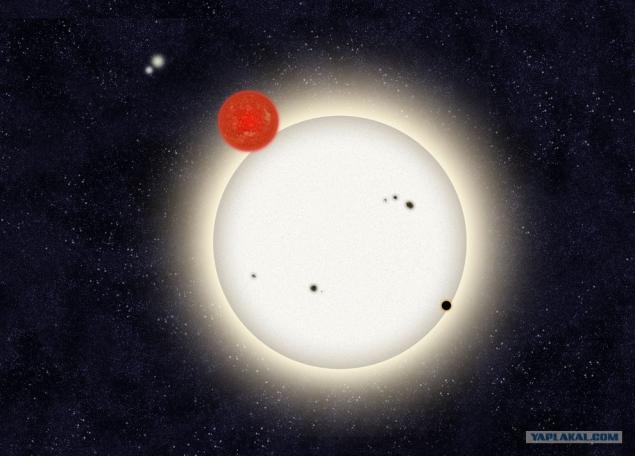
10. Kepler-36b and Kepler-36c
Astronomers were surprised very close proximity of these two very different planets, their orbits are so close to each other like no other previously discovered planets orbit.

Source:
10 photos + text here

1. WASP-12b
Astronomers saw a cosmic cataclysm: the star absorbs own planet, which was in close proximity to it. This is an exoplanet WASP-12b. It was discovered in 2008.
WASP-12b, as well as most of the known extrasolar planets, is a big gas world. However, unlike most other extrasolar planets, WASP-12b revolves around its star at very close range - a little over 1, 5 million kilometers (75 times closer than the Earth is from the Sun).
Huge world WASP-12b has already looked into the face of his death, the researchers said. The main problem of the planet - its size. It has grown to such an extent that it can not keep its matter against the forces of gravity mother star. WASP-12b gives stellar matter with great speed: six billion metric tons each second. The planet will be completely destroyed by the star in about ten million years. By cosmic standards, it is quite a bit.

2. TrES-2b
The darkest exoplanet - a distant, Jupiter-sized, gas giant.
Measurements showed that the planet TrES-2b reflects less than one percent of the light, making it blacker than coal and naturally darken any of the planets of the solar system. The work dedicated to this planet, was published in the Journal of the Royal Astronomical Society Monthly Notices. Planet TrES-2b reflects less light than even black acrylic paint, so it's really dark world.

3. HD 189733b
This object orbiting a star, remote from us at a distance of 63 light years. Although this sounds like a planet the size of Jupiter, because of its proximity to its star, it is much hotter than the gas giant in our solar system. As with the other planets found hot, synchronized rotation of the planet and its orbital motion - a planet always faces the star of one side. The orbital period is 2.2 Earth days.

4. TrES-4
The biggest planet of the found in the universe - is TrES-4. It was discovered in 2006 and it is located in the constellation Hercules. The planet orbits the star, which is located about 1,400 light years from Earth.
The researchers argue that the diameter of the planets discovered almost 2 times (or more precisely in the 1, 7), the diameter of Jupiter (it is the biggest planet in the solar system). TrES-4 temperature about 1,260 degrees Celsius.

5. COROT-7b
Year on COROT-7b takes just over 20 hours. It is not surprising that the weather in the world, to put it mildly exotic.
Astronomers have suggested that the planet is composed of cast and solid rock, not from frozen gases that certainly will boil at such usloviyah.Temperatura falls to 2000 C on the illuminated surface to -200 C at night.

6. PSR and PSR 1257 b 1257 c
Two planets revolve around the dying star.

7. Kepler-10b
With Space Telescope, astronomers were able to detect the smallest rocky exoplanet, whose diameter is about 1, 4, the diameter of Earth.
The new planet was designated Kepler-10b. The star around which it rotates, is located about 560 light years from Earth in the constellation Draco, and similar to our sun. Belonging to the class of "super-Earths», Kepler-10b is the rather close to its luminary orbit, making a turn around for just 0, 84 Earth days, the temperature in it reaches several thousand degrees Celsius. According to the scientists, with a diameter of 1, 4 diameter of the Earth Kepler-10b has a lot of 4 and 5 of the earth.

8. Kepler-16b
Analysis of the data on the system Kepler-16 showed that it opened in June 2011 exoplanet Kepler-16b rotates once around the two stars. If the observer could be on the surface of the planet, it would have seen as the rising and setting of the sun, two, just like on the planet Tatooine from the fantastic saga "Star Wars."

9. PH1
Through the joint efforts of amateur astronomers who participated in the project Planet Hunters, and professional astronomers have discovered a planet in a system of four stars. The planet orbits two stars, around which, in turn, treated two more stars.

10. Kepler-36b and Kepler-36c
Astronomers were surprised very close proximity of these two very different planets, their orbits are so close to each other like no other previously discovered planets orbit.

Source:



